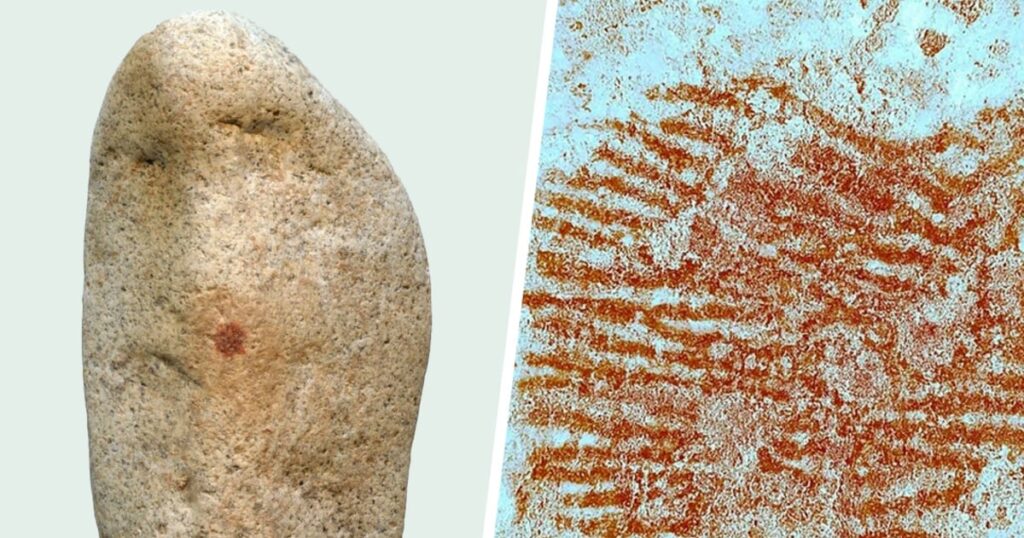Ancient Evidence of Artistic Expression in Neanderthals Challenges Long-Held Assumptions
Recent archaeological findings from Spain suggest that Neanderthals may have possessed the capacity for creating symbolic art, a trait traditionally attributed solely to anatomically modern humans. This groundbreaking discovery prompts a reevaluation of the cognitive abilities of our extinct relatives and their potential for cultural expression.
The Discovery: A Mysterious Pebble with a Human-Like Face
In 2022, researchers unearthed a distinctive quartz-rich granite pebble from a cave site in central Spain. The artifact measures over 8 inches in length and features natural curves and indentations that resemble a human face. Notably, the surface bears a solitary red dot positioned where a nostril would be, sparking curiosity about its significance.
Analysis revealed that the red pigment was ocher, a natural earth pigment commonly used by early humans and Neanderthals for decoration or symbolic purposes. The key question was how this pigment came to be on the pebble and whether it was applied intentionally.
Uncovering the Significance of the Red Dot
Advanced forensic techniques confirmed that the red mark was a fingerprint, indicating deliberate application by a finger dipped in ocher. This discovery was verified by Spanish forensic experts, leaving no doubt that the Neanderthal who handled the pebble intentionally decorated it.
Based on the fingerprint’s characteristics, researchers believe the individual was likely an adult male. The placement of the pigment, combined with the pebble’s facial resemblance, suggests that the Neanderthal perceived the object as a face-a phenomenon known as pareidolia, where the mind interprets random patterns as familiar images.
Lead researcher David Álvarez-Alonso emphasized that this act of marking the pebble represents an early form of symbolic behavior, a simple yet profound expression of cognitive complexity.
Implications for Understanding Neanderthal Cognition
This find is considered particularly remarkable because it constitutes the most complete Neanderthal fingerprint ever discovered, surpassing previous partial evidence found in Germany. Such discoveries are reshaping perceptions of Neanderthal intelligence and cultural capacity.
Neanderthals, a robust species characterized by broad noses and stocky builds, coexisted with early Homo sapiens in Europe, Asia, and the Middle East for hundreds of thousands of years before their extinction approximately 40,000 years ago. Despite their physical differences, recent studies suggest that Neanderthals possessed comparable levels of cognitive ability to early modern humans.
Symbolic Behavior and Its Significance
While the pebble’s decoration is a modest example, it adds to a growing body of evidence indicating that Neanderthals engaged in symbolic activities. Such behaviors include the use of pigments, personal adornments, and possibly even rudimentary art forms. However, Álvarez-Alonso cautions that this object remains unique and lacks direct parallels, making it difficult to draw broad conclusions.
He notes that Neanderthals likely did not develop the complex symbolic systems seen in Homo sapiens, but this discovery suggests they possessed a level of mental flexibility capable of producing symbols and perhaps communicating ideas through visual means.
“This pebble does not resolve all questions about Neanderthal cognition,” Álvarez-Alonso states, “but it provides another piece of evidence pointing to a sophisticated mind capable of symbolic thought.”
Broader Context and Future Directions
As research continues, scientists are increasingly recognizing the cognitive and cultural sophistication of Neanderthals. These findings challenge outdated notions of them as purely instinct-driven beings and highlight their potential for symbolic and artistic expression. Future excavations and analyses may uncover more artifacts that deepen our understanding of their mental worlds.
In the broader scope of human evolution, such discoveries underscore the importance of reexamining the cognitive boundaries between Neanderthals and early modern humans, revealing a more nuanced picture of our shared history.

